Norway have produced a number of excellent young talents every year and we’ve covered a lot of them on our website. Martin Odegaard, Erling Braut Haland, and Sander Berge are only a few of many that are rising through the ranks of Norwegian teams. Many have even become the starter of their respective teams at under 20.
Another player that we’ll take a closer look at in this scout report is Joshua Kitolano from Odds. The 2001-born player has been on the receiving end of some high praises since making his senior debut on 15 April 2018 against Stromsgodset in Eliteserien. That season he made a total of 17 senior appearances for Odds, scoring two goals an creating one assist.
Now the 2019 Eliteserien season has been going for a while and he’s receiving a considerable amount of playing time again. He has made a total of 10 appearances across all competitions, scoring only a single goal. However, he has been a pivotal part in the team as he contributes a lot both offensively and defensively.
His brother, John Kitolano, is a left-back who previously also played for Odds before moving to Wolves in the summer of 2018. A lot of eyes will be watching him throughout the year, but will he follow his brother’s footsteps and make the big move to Europe’s top five leagues soon? We shall see about that. But in the meantime, let’s take a closer look at Joshua to see how good he actually is and how he fits into his team’s tactics.
In this tactical analysis, we’ll take a closer look at the talented teenager who’s currently plying his trade at Odds.
Physical
Lacks strength
Standing at 1.7 m (5’6″) tall, Kitolano’s a bit on the smaller side. He has a lean body build with visible muscle. That means he may be small, but he doesn’t really lack strength as much as you think he does. But still, much larger and stronger players don’t seem to have a hard time jostling against him.
Aside from the lack of strength, his small physique also means that he’d reach lesser height vertically. This makes him less of a threat in offensive aerial duels, but also less useful in defensive aerial duels. Odds, of course, still have taller players in the midfield to help win aerial duels for him while he positions himself to receive the second ball. Defensive midfielder Fredrik Jensen often covered his area (left side of centre-mid) to receive the opposing team’s goal-kicks.
Statistically, Kitolano only made around 2.3 aerial challenges per game with a success rate of merely 36% on average. Kitolano also doesn’t seem to be the most proficient of headers. He doesn’t seem to be able to direct his headers accurately whenever he wins aerial duels. He also can’t generate enough power with his headers to reach further distance.
Quick, agile, and great stamina
But despite his lack of upper-body strength, Kitolano has quite a good body balance and agility as well as coordination. He has a low centre of gravity due to his lack of height and good core strength. This can be seen when he’s dribbling and it seems to help him a lot. He’s quite hard to shrug off the ball, especially when he’s in his stride. But as mentioned earlier, he can’t hold the ball for far too long as he’d eventually be outmuscled by bigger and stronger players. Centre-mids who have good body balance and agility tend to be good at ball-retention if they also have the proper technical and tactical ability. We’ll get to that later in this tactical analysis.
Kitolano also seems to possess decent speed in him. Not great, but at least good enough for shorter distances. He’s pretty quick when accelerating which if combined with his ability to turn his body and manoeuvre quickly, could help him beat defenders easily, especially in tight spaces.
Aside from speed and strength, another important physical aspect of Kitolano is his stamina – which he has plenty of. He seems to never stop running throughout the full 90 – doesn’t even seem to get tired. He usually only covers his side of midfield (left side), only on rather rare occasions seen covering other sides of the pitch. But he does his job very well – he runs up and down, non-stop.
Technical
Kitolano is pretty decent technically, but not that great either.
Defensively, he’s good ball-winner. He’s aggressive and determined in his tackles. He knows when to time his tackles and he’s not afraid to get stuck in. He made around 4.6 tackles per game, completing 53% on average. He’s also involved a lot defensively – albeit usually only around the middle third. He made around 5.9 defensive challenges (challenges against opposition who has the ball) per game, completing 47% of them. In 1v1 defence, he thrives – but he’s not a very proficient defender overall.
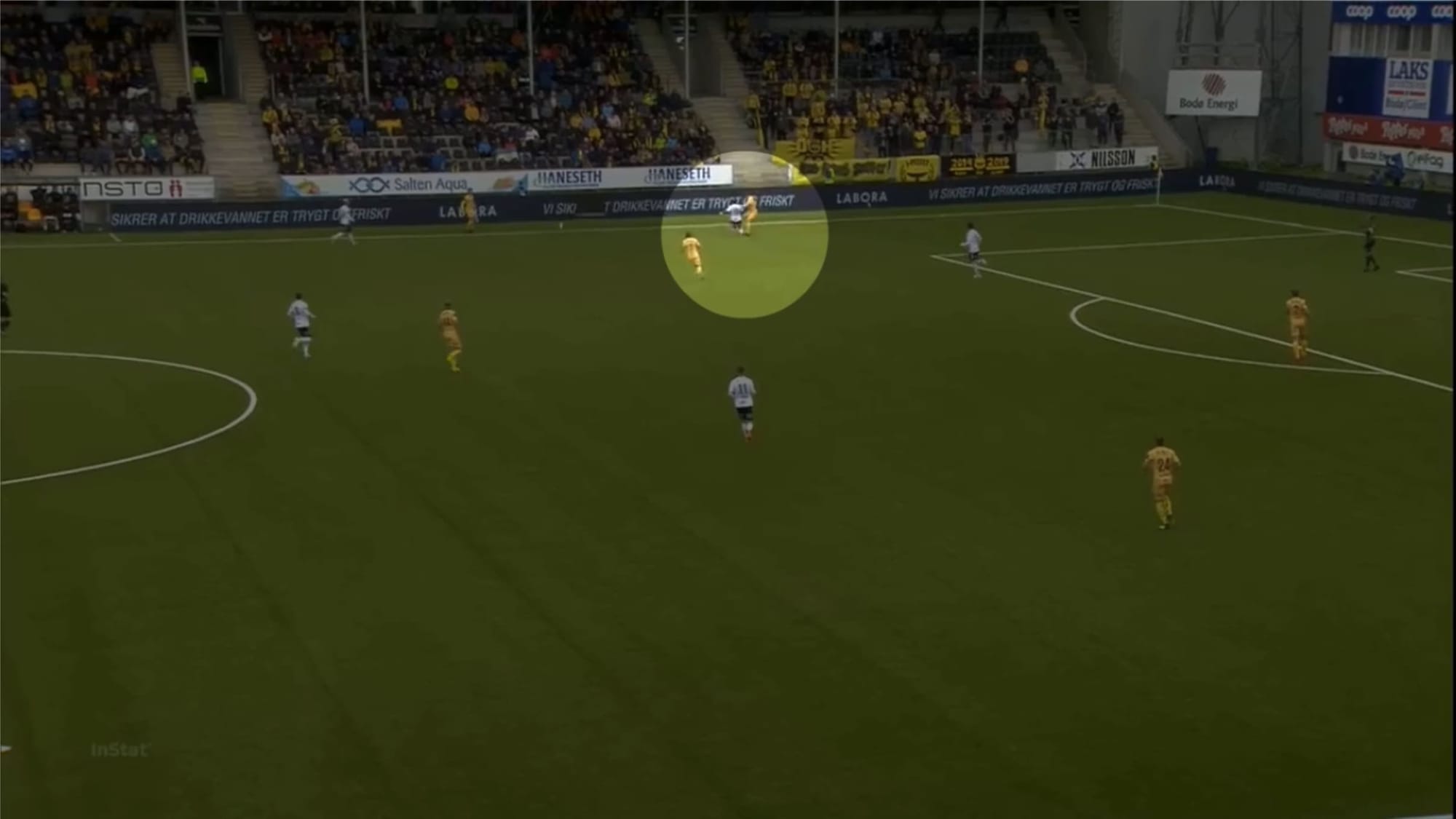
Kitolano is mostly right-footed but also pretty good at using both feet. He seems able to control the ball, dribble, and pass it with either foot although he seems to have a tendency to avoid using his weaker foot.
The 17-year-old has a good first touch. He’s also able to control the ball closely and manoeuvre with the ball quickly and with high mobility. This surely helps him a lot to get out of aggressive presses by the opposition. He’s actually pretty good at retaining the ball in tight spaces, but a lot of times he just doesn’t know what to do next and loses it in the end.
The centre-mid is also a pretty good passer. His team play mostly using short-medium range passes which he excels in. He has good eyes for a pass and he usually executes his pass with very good weight and accuracy. Statistically, Kitolano managed to make 31 passes per game with 83% accuracy on average. That is, of course, decent – not the most impressive stats for a centre-mid who’s actively involved in making the play. Kitolano also makes only around 0.42 long passes per game out of those 31 total. This certainly shows his tendency to play it short rather than going long, even in counter-attacks – although this may be affected by his team’s style of play.
In terms of finishing, Kitolano is pretty decent. His shots, both from long and short-range, are quite accurate. He averaged around 0.6 shots per game, with 0.3 (50%) of them being on target. Most of his shots are from outside the box. This is mostly due to his positioning around the edge of the box to recover spill outs.
He has scored only three goals so far from 2018 to 2019 (33 games in all competitions) which is quite impressive considering he has only collected a very low xG value of around 1.7. His shots are quite accurate, but we still can’t define him as an excellent finisher.
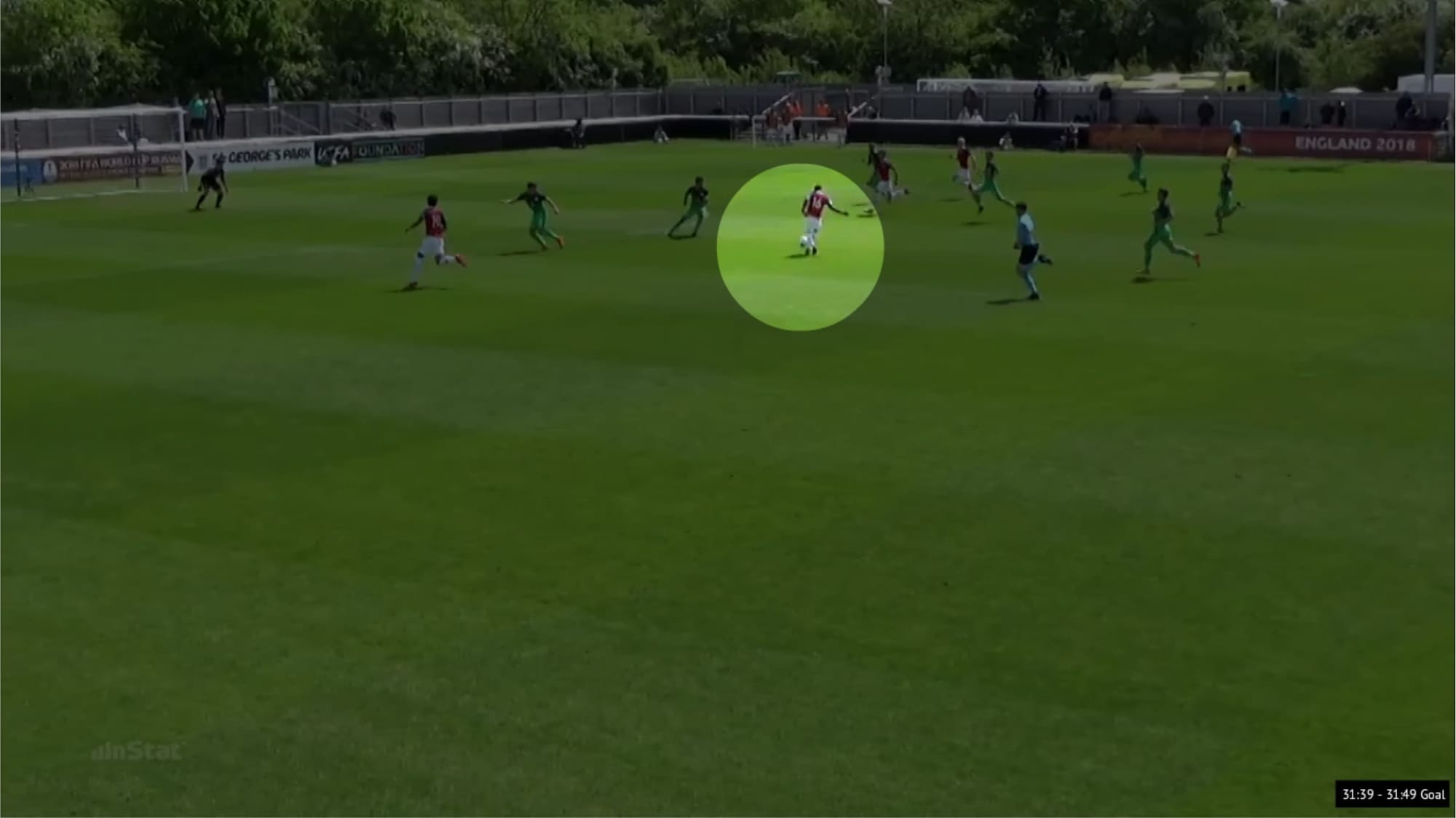
Aside from his goal tally, Kitolano has also notched up a staggeringly low number of assist. From the total of 33 games played across all competitions, he has only created two assists. Despite that, we can still say that Kitolano does contribute heavily to his team’s attacks if we look at his key passes stats. The small centre-mid made around 1.1 key passes per game with the high success rate of 54%.
But if that so, then why does he have a rather unimpressive statistics offensively? That is due to his role in the centre of the field, which we will talk about later in this analysis.
Tactical
His role in the team
Kitolano’s role as a central midfielder seems to vary depending on which team he’s playing for. In Odds II, Kitolano seems to play a more active role, dropping deep and getting into the box. He probably plays as a box-to-box midfielder. Meanwhile, in the senior side, he’s a bit less active. He drops deep quite a lot to help his team build their play up from the back but usually, he’d hold his position in around the middle third – only occasionally seen around the edge of the box when his team are in the final phase of an attack.
He’s quite flexible tactically and very versatile as well. He has so far played in every position on either side of the flank. He has also played in a wide range of role in the centre of the field, from being a defensive midfielder to an attacking midfielder. Despite that, it’s quite clear that he enjoys playing as a central midfielder the most – and he seems to fit that position best.
Playing in a team that plays a 4-3-3 system, Kitolano usually plays in the left side of the centre-mid pair. His partner, Vebjorn Hoff, is also very active – often waits around the edge of the box or even arriving late inside the box to meet a cross.
Here’s how the line-up usually looks if he plays in the team.
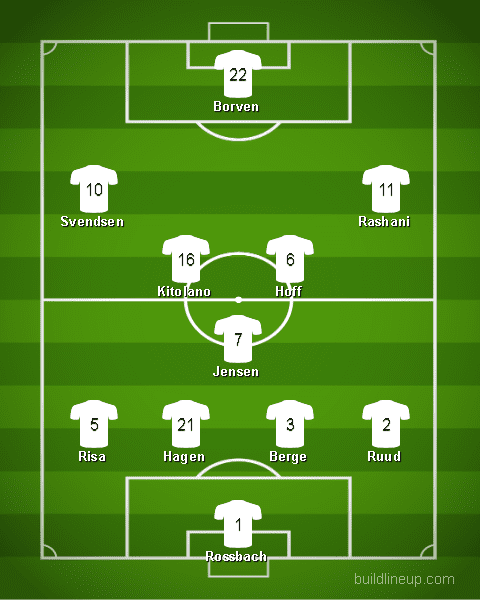
His team plays a very patient, possession-based game. They tend to move the ball a lot laterally, trying to find gaps in wider areas to exploit. Most of their exchange is short, only playing longer-range passes if forced.
In this system, Both Kitolano and Hoff are the links between the defence and the forwards. That’s why he doesn’t really have much room for movements as his main task is pretty much to distribute and progress the ball forward after dropping deep and receiving the ball from the defenders. He also doesn’t have to roam wide as his team plays with offensive full-backs who tend to sit high to attack the flanks. We can see his movements in the centre of the field through this heatmap.
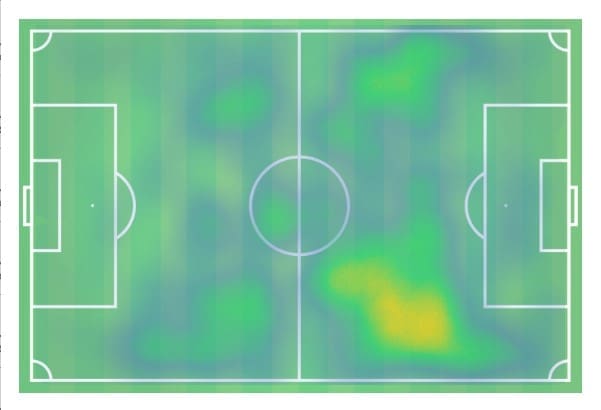
As we can see here, he plays mostly around the left side, positioning himself rather deep. Some of the time, when his team are in the attacking phase, he’s waiting around the edge of the box, but mostly he’d hold his position around the middle third inside the half-space. This is so that he can link up with winger Sander Svendsen as well as left-back Birk Risa on the left flank.
Spatial awareness, positioning, and off the ball movements
Being a smaller, weaker midfielder – Kitolano needs to be smart in the game, especially when playing against teams who block high and press aggressively. From what I’ve seen so far, Kitolano does have a pretty good spatial awareness. He makes use of any space provided to him smartly. He also knows where and how to position himself to receive the ball. Instead of facing his passer directly with his back facing the opposing team’s goal, he usually orientates his body in a way that he could have a clear vision of the field which allows him to pass the ball forward and help his team progress. Again this also helps him get out of pressure easily instead of having to hold the ball and hold off the opposing defender.
Occasionally, Kitolano will position himself in pockets of space, providing a passing option for Hagen, Jensen, and Risa instead of dropping deep.
Playing in the senior side of Odds, Kitolano doesn’t get a lot of freedom in movements. But in the Odds II, he seems to enjoy exploiting spaces in behind the defence as he makes his runs between defenders. He loves arriving inside the box to receive the through pass from the playmaker as well as wait around the box for spill outs.
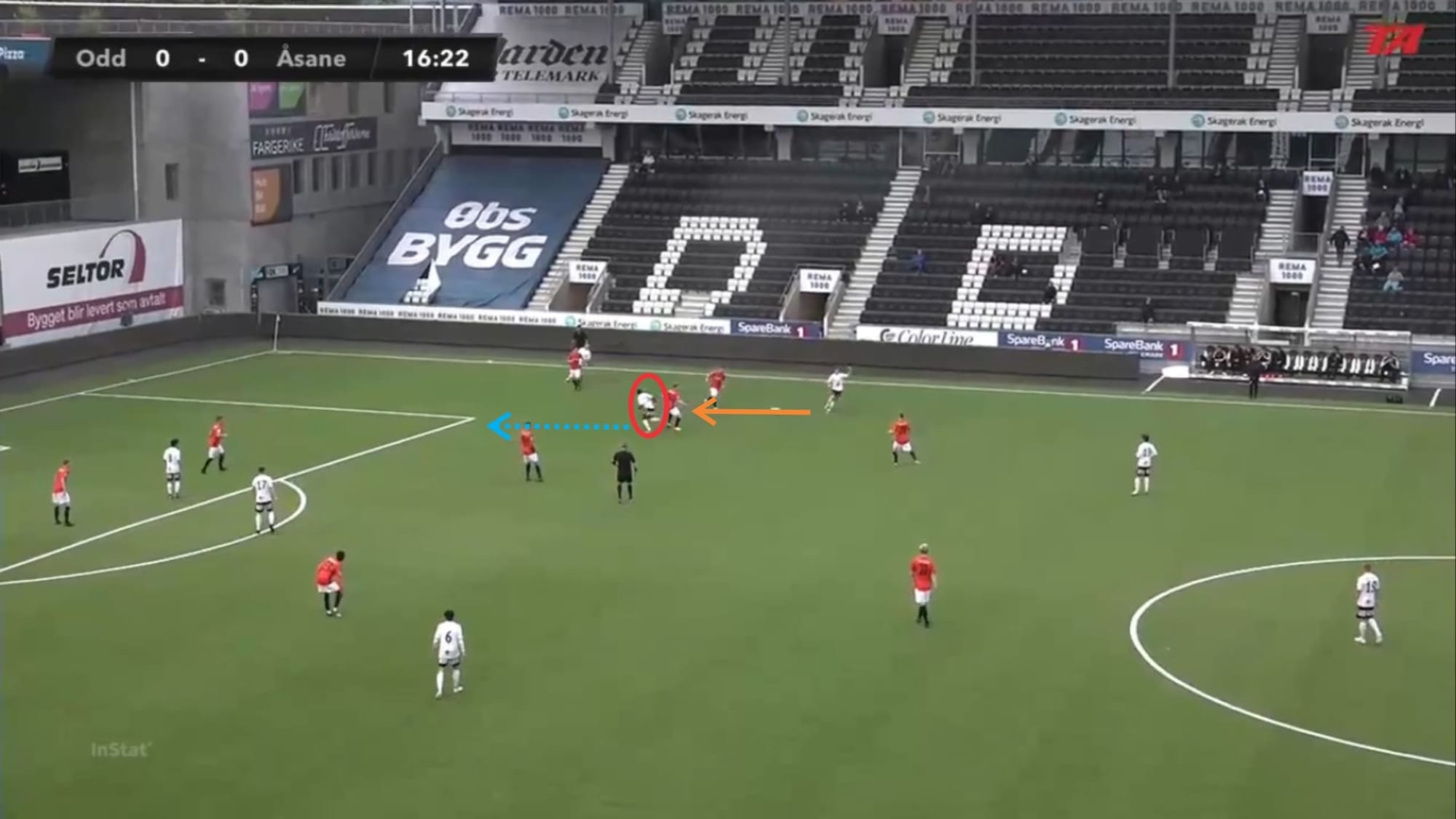
Here we can see Kitolano making the run behind the defender which triggered a through pass from the right-winger. The opposing team’s defender was not aware of his movements which left Kitolano free of any marker. The advancing central midfielder then brought the ball into the box and took a shot which was on target but saved by the goalkeeper.

We can also see from the series of pictures above. In the first picture, Kitolano dropped deep to link up with the backline and provide a passing option. As mentioned before, Odds II tactics allowed him the freedom to move further forward and explore the final third. In this system, Kitolano was used effectively as a means to surprise the opposing backline.
Kitolano lost his marker while dropping deep, but his teammate didn’t pass the ball to him as he could potentially be swarmed by the five opponents nearby. His team moved the ball around the back again while Kitolano immediately pushed forward in search of space. He tried to make a run behind the defence while playing off the shoulder of the opposing defender. The ball-playing defender made the long pass forward and found Kitolano free in some space inside the box. This caught the opposing defence (who defended with a high block) by surprise, especially the two centre-backs who were busy paying attention to the Odds II striker instead of watching Kitolano’s movements.
Kitolano has a decent vision for a pass, but he’s a bit vulnerable under pressure. Despite actually having the ability to break out of pressure, Kitolano doesn’t like finding himself isolated and preferred to play quick one-two touch passes to avoid the pressure. Of course, sometimes his passes seem rushed and fail to find his intended target.
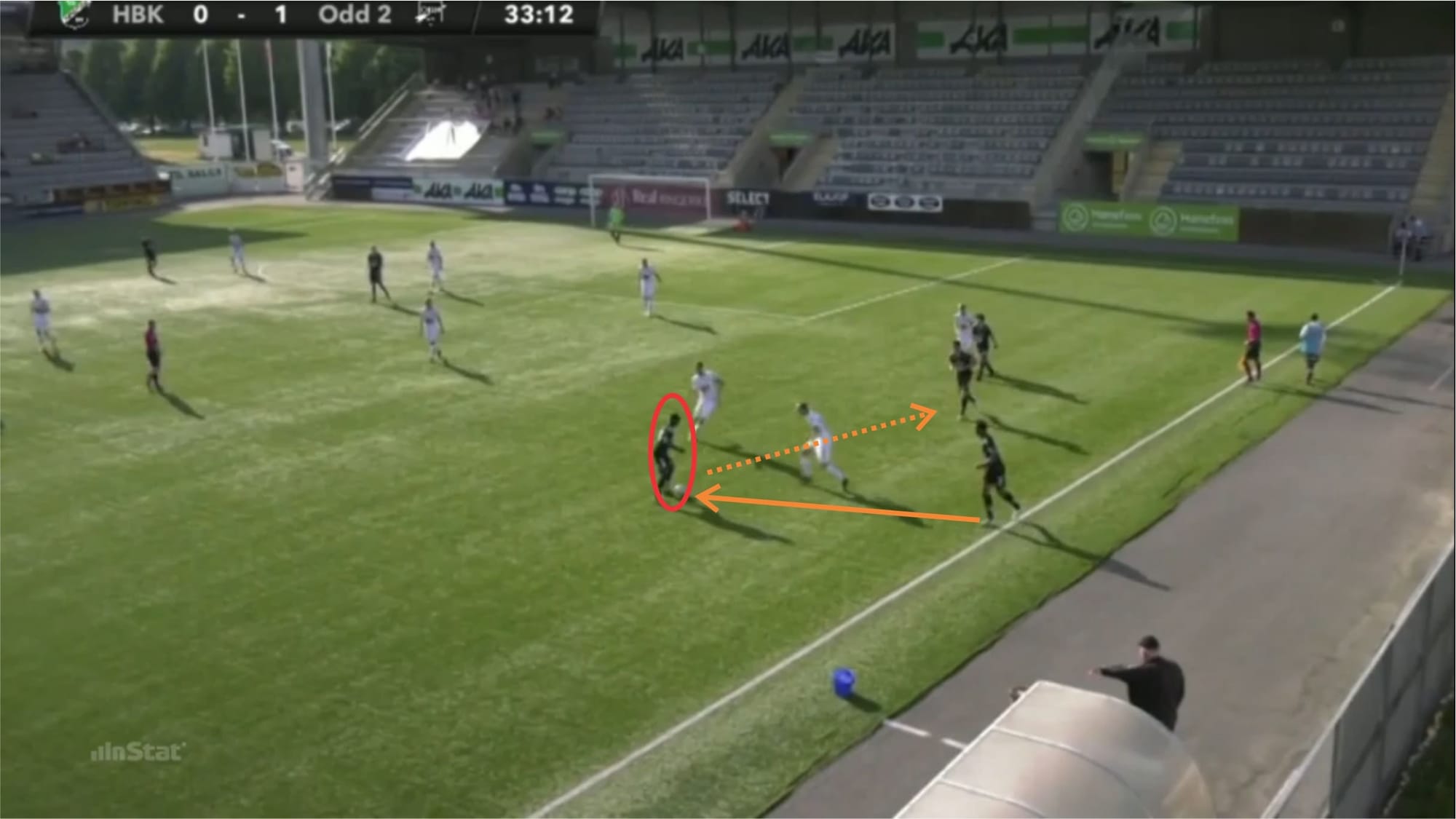
Rather poor defensive prowess
Kitolano may be quite a good tackler, but is he a good defender overall? Well, not really. The 17-year-old midfielder reads the game fairly well but is a bit lacking in concentration. He often fails to anticipate the opposing attacker’s movements which sometimes could be a bit fatal.
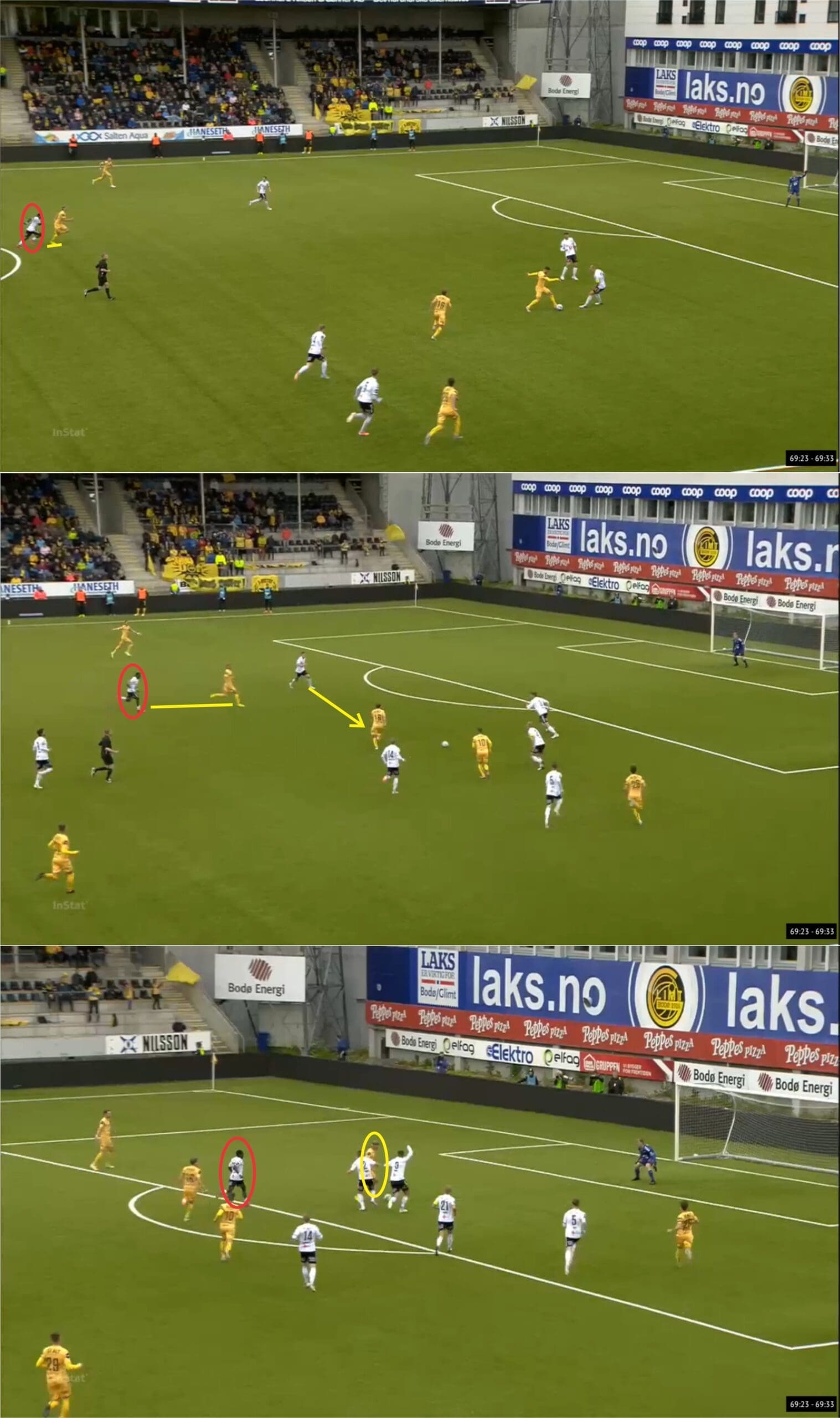
Now in this picture, we can see Kitolano’s weakness in defence. In the first picture, we can see that Kitolano is tracking back and staying close to Bodo/Glimt’s midfielder Ulrik Saltnes. The latter marched forward to exploit the space between Odds’ right-back and right centre-back which was created due to Fredrik Berge drifting out of position. We can also see on the right side of the defence, Espen Ruud is looking to mark the half-space zone so that he’d still be able to anticipate the pass to Bodo/Glimt’s left-winger Amor Layouni as well as the pass to central midfielder Saltnes.
Meanwhile, in the second picture, we can see that Kitolano started losing his man and just jogged instead of sprinting to catch up. Now Saltnes is definitely not the quickest of player, so Kitolano not staying tight with him means that he didn’t try to – not that he couldn’t keep up with the former’s pace. He looked as if he’s not sure whether to follow him deep into the box or not and decided to just stay outside. He might have thought that Ruud – who has now covered the half-space – may be able to anticipate and intercept the through pass towards Saltnes.
Ultimately, the right-back failed to intercept the pass and Saltnes was left completely free inside the box with all the time in the world. The Bodo/Glimt midfielder scored a simple and easy goal, just because Kitolano let him. Had he stayed tight with him, he may be able to make the interception inside the box, or perhaps make a last-ditch tackle, or at least disrupt his attempt at shooting.
This happened numerous times throughout the season. He’s not bad at reading the game. In fact, he’s actually pretty good at intercepting the ball, making at least four interceptions per game. He knows where the ball is going to be and when to time his interceptions, but sometimes he doesn’t know where to position himself defensively. From the picture above we can also see that he’s not very good at marking. He’s unable to stay with his man most of the times because of his tendency to watching the ball instead of focusing to anticipate his direct attacker’s movements.
Mental
Kitolano has a good off the ball and on the ball skills but as mentioned previously, he hates being under pressure and isolated from his teammates. He’s a bit vulnerable in this situation and this is where he usually loses most of the ball. Marking him tightly and immediately closing him down could do the job if you’re playing against his team.
The central midfielder is also a bit prone to mistakes – which could be due to his lack of concentration. Numerous times throughout the 2018 and 2019 season, Kitolano was seen as the weak link defensively. He easily lost his direct attacker due to his tendency to watch the ball rather than pay attention to his opponent’s movements – as explained above.
This has also been mentioned earlier – that Kitolano has a pretty good amount of aggression in every game. He won’t shy away to get stuck into rough challenges. He’s not afraid to go against much bigger and stronger opponents in any duels. He’s always committed in every game, seemingly playing his hearts out until the full 90. He works well in the team and communicates pretty well – rarely reacting negatively to any failed effort from his teammates. Despite being rather aggressive in his play, Kitolano also seems to be able to keep his temper.
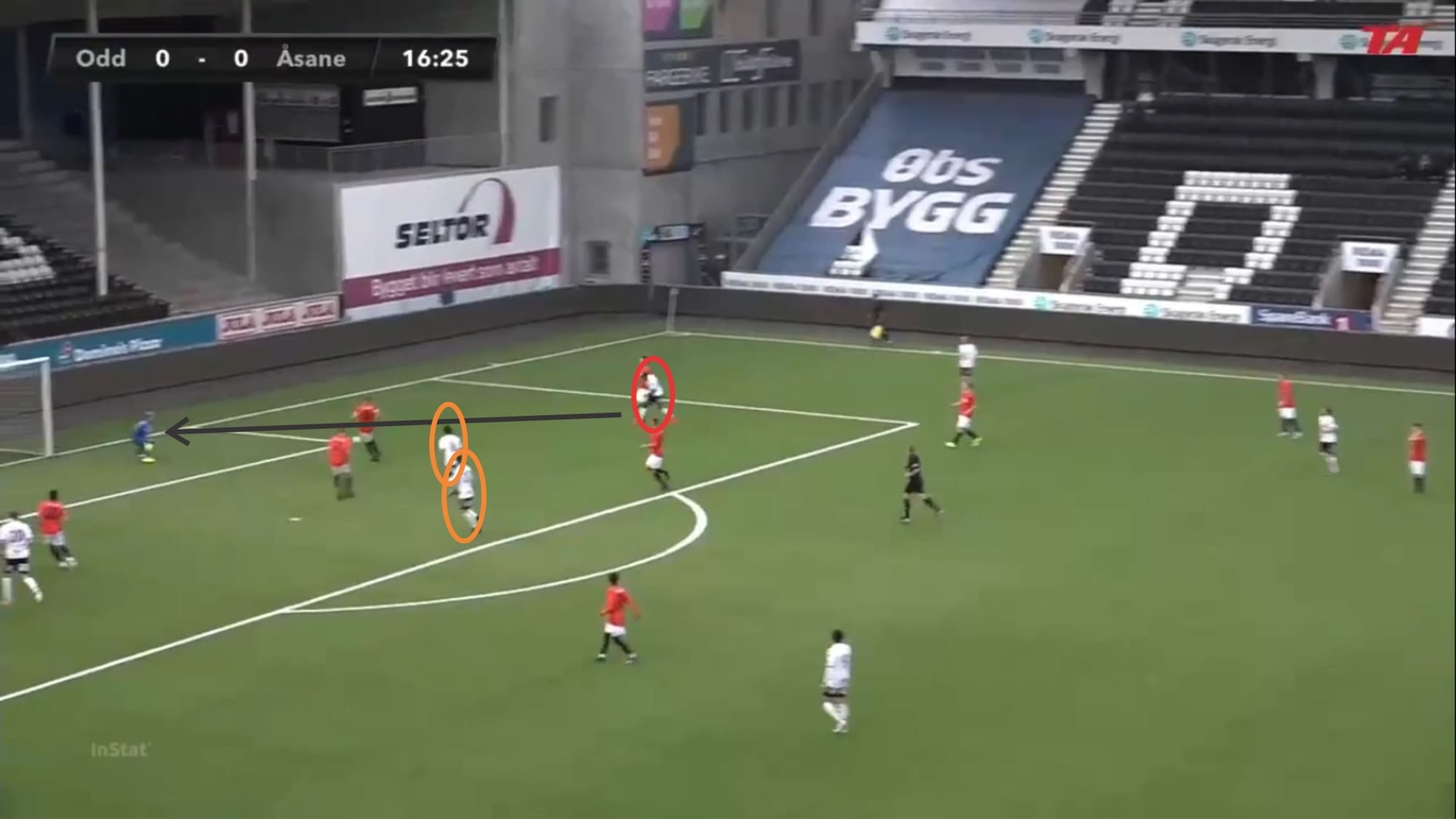
However, Kitolano still has to improve his decision making. Sometimes, even when free of any pressure, Kitolano still seems to be hesitant in making a decision. Eventually, the opposing defender catches up with him and able to win the ball from him as he takes too long in making his decision. There are other times when he also takes a shot from a rather difficult position instead of giving it to his teammates who are standing in more favourable positions like in the picture above.
Conclusion
Odds’ 17-year-old Kitolano is surely talented but still has some aspects in his game that he needs to improve. He already has good attributes all-around, only lacking mostly in his physical strength. However, that is something that he can still improve throughout the years.
Kitolano is very versatile and he always gives his all in every position he plays. Despite being rather one-footed, Kitolano tends to play smartly – utilising his body orientation and positioning himself to receive and deliver the ball in such a way so that he can link up using his favoured right foot.
He is quite proficient overall technically-speaking and he is quite flexible tactically. However, despite his team employing him in a rather strict role, allowing him only a little bit of room for movements – Kitolano likes to occasionally improvise and surprise the opposing team’s defence by making runs into the box.
The young central midfielder is a very good team player – he works hard and communicates pretty well, although there are some mental aspects that he should improve – which I believe he will, as he gets older and gains experience in the game.
As for now, the level he could be playing in Europe is quite low. It’s definitely better for him to stay at Odds and hone his craft. He needs to get more playing time. Perhaps a loan move would be perfect, but as far as I can see, his team have given him a respectable amount of chances to play – which is great.
If you love tactical analysis, then you’ll love the digital magazines from totalfootballanalysis.com – a guaranteed 100+ pages of pure tactical analysis covering topics from the Premier League, Serie A, La Liga, Bundesliga and many, many more. Buy your copy of the June issue for just ₤4.99 here, or even better sign up for a ₤50 annual membership (12 monthly issues plus the annual review) right here.

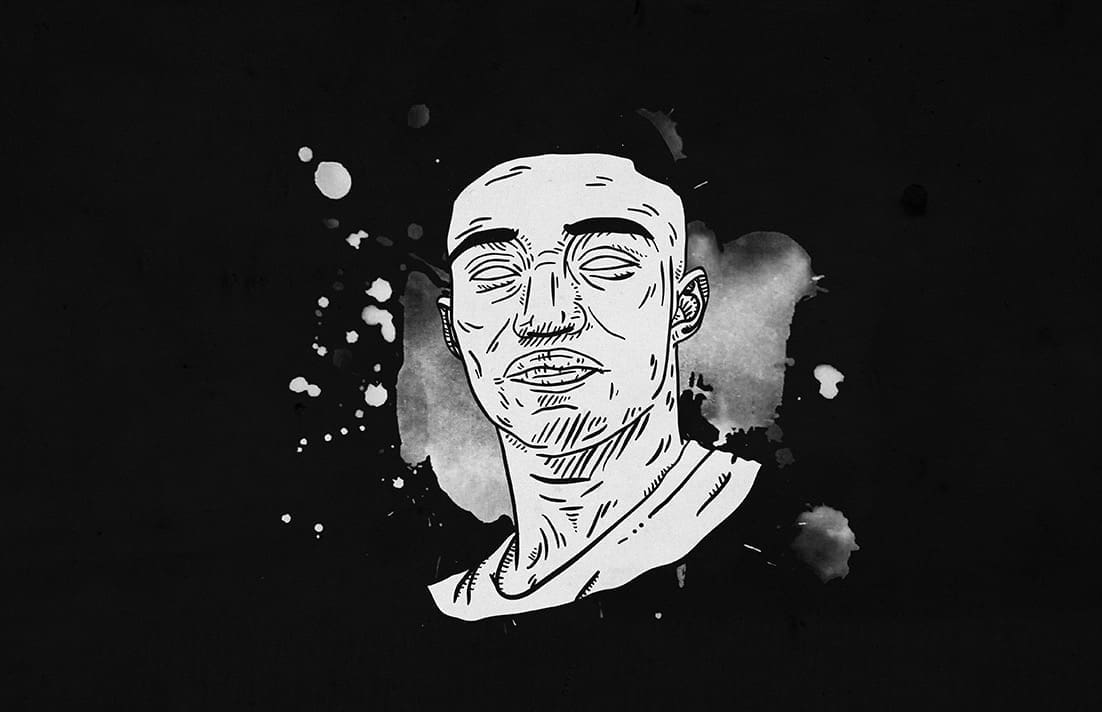



Comments